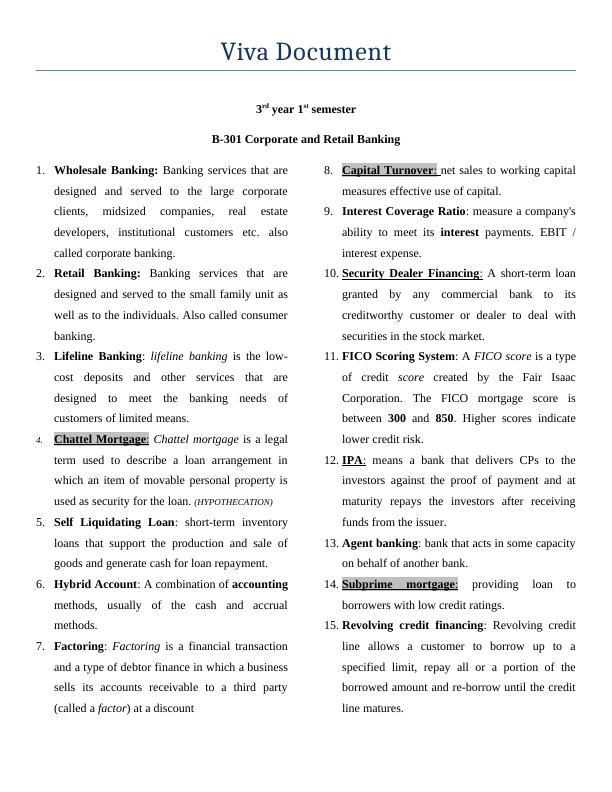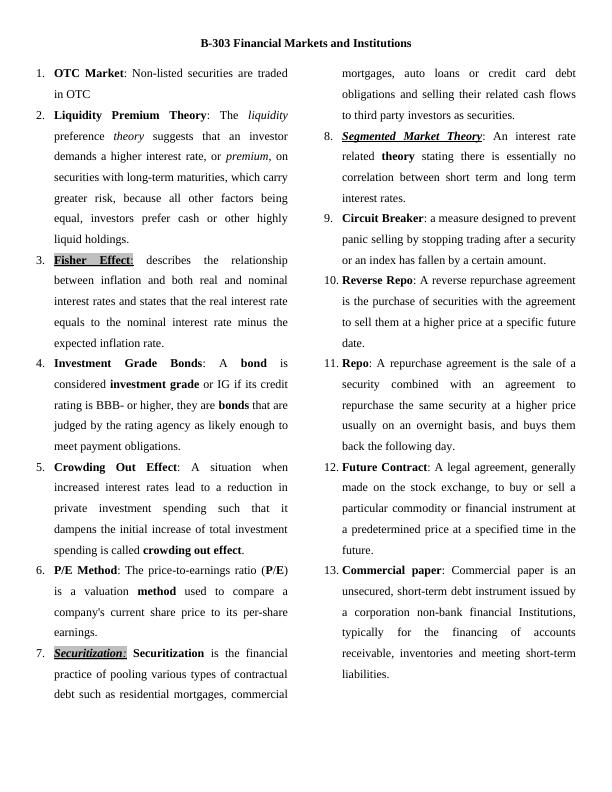Corporate and Retail Banking Assignment
16 Pages4605 Words44 Views
Added on 2020-11-02
Corporate and Retail Banking Assignment
Added on 2020-11-02
ShareRelated Documents
Viva Document3rd year 1st semesterB-301 Corporate and Retail Banking1.Wholesale Banking: Banking services that aredesigned and served to the large corporateclients, midsized companies, real estatedevelopers, institutional customers etc. alsocalled corporate banking.2.Retail Banking: Banking services that aredesigned and served to the small family unit aswell as to the individuals. Also called consumerbanking.3.Lifeline Banking: lifelinebanking is the low-cost deposits and other services that aredesigned to meet the banking needs ofcustomers of limited means.4.Chattel Mortgage:Chattel mortgage is a legalterm used to describe a loan arrangement inwhich an item of movable personal property isused as security for the loan. (HYPOTHECATION) 5.Self Liquidating Loan: short-term inventoryloans that support the production and sale ofgoods and generate cash for loan repayment.6.Hybrid Account: A combination of accountingmethods, usually of the cash and accrualmethods.7.Factoring: Factoring is a financial transactionand a type of debtor finance in which a businesssells its accounts receivable to a third party(called a factor) at a discount8.Capital Turnover:net sales to working capitalmeasures effective use of capital.9.Interest Coverage Ratio: measure a company'sability to meet its interest payments. EBIT /interest expense.10.Security Dealer Financing: A short-term loangranted by any commercial bank to itscreditworthy customer or dealer to deal withsecurities in the stock market.11.FICO Scoring System: A FICO score is a typeof credit score created by the Fair IsaacCorporation. The FICO mortgage score isbetween 300 and 850. Higher scores indicatelower credit risk.12.IPA: means a bank that delivers CPs to theinvestors against the proof of payment and atmaturity repays the investors after receivingfunds from the issuer.13.Agent banking: bank that acts in some capacityon behalf of another bank.14.Subprime mortgage: providing loan toborrowers with low credit ratings. 15.Revolving credit financing: Revolving creditline allows a customer to borrow up to aspecified limit, repay all or a portion of theborrowed amount and re-borrow until the creditline matures.

B-302 Government Finance and Business Taxation1.Counterfactual : (if he had done that types)(unreal present) A counterfactual assertion is aconditional whose antecedent is false and whoseconsequent describes how the world would havebeen if the antecedent had obtained.2.Public Finance: Economic study that analysisgovt. income and spending. Public income andspending are part of macroeconomics. 3.Additive Social Welfare Function: Anequation that states the social welfare as the sumof individual’s utilities.4.Indirect Tax: An indirect tax is a tax that ispaid to the government by one entity in thesupply chain, but it is passed on to the consumeras part of the price of a good or service.5.Free Rider Problem: Free rider problem is theincentives to let other people pay for a publicgood while enjoying the benefits himself.6.Pigouvian Subsidy: A Pigouvian subsidy is asubsidy provided to an activity on the groundsthat the activity generates external benefits 7.Externalities: When the activity of one entity (aperson or a firm) directly affects the welfare ofanother in a way that is not transmitted bymarket prices.8.Negative Tax: In economics, a negative incometax (NIT) is a progressive income tax systemwhere people earning below a certain amountreceive supplemental pay from the governmentinstead of paying taxes to the government9.Coase Theorem: Provided that transaction costsare negligible, an efficient solution to anexternality problem is achieved as long assomeone isassigned property rights,independent of who is assigned the rights. 10.Total World Income: Total world incomeincludes the income received or deemed to bereceived, income (arises/accrues) or deemed tobe (arise/accrues) of a non-resident inside BDand also his income outside of BD.


B-303 Financial Markets and Institutions1.OTC Market: Non-listed securities are tradedin OTC2.Liquidity Premium Theory: The liquiditypreference theory suggests that an investordemands a higher interest rate, or premium, onsecurities with long-term maturities, which carrygreater risk, because all other factors beingequal, investors prefer cash or other highlyliquid holdings.3.Fisher Effect: describes the relationshipbetween inflation and both real and nominalinterest rates and states that the real interest rateequals to the nominal interest rate minus theexpected inflation rate.4.Investment Grade Bonds: A bond isconsidered investment grade or IG if its creditrating is BBB- or higher, they are bonds that arejudged by the rating agency as likely enough tomeet payment obligations.5.Crowding Out Effect: A situation whenincreased interest rates lead to a reduction inprivate investment spending such that itdampens the initial increase of total investmentspending is called crowding out effect.6.P/E Method: The price-to-earnings ratio (P/E)is a valuation method used to compare acompany's current share price to its per-shareearnings.7.Securitization:Securitization is the financialpractice of pooling various types of contractualdebt such as residential mortgages, commercialmortgages, auto loans or credit card debtobligations and selling their related cash flowsto third party investors as securities.8.Segmented Market Theory: An interest raterelated theory stating there is essentially nocorrelation between short term and long terminterest rates.9.Circuit Breaker: a measure designed to preventpanic selling by stopping trading after a securityor an index has fallen by a certain amount.10.Reverse Repo: A reverse repurchase agreementis the purchase of securities with the agreementto sell them at a higher price at a specific futuredate. 11.Repo: A repurchase agreement is the sale of asecurity combined with an agreement torepurchase the same security at a higher priceusually on an overnight basis, and buys themback the following day.12.Future Contract: A legal agreement, generallymade on the stock exchange, to buy or sell aparticular commodity or financial instrument ata predetermined price at a specified time in thefuture.13.Commercial paper: Commercial paper is anunsecured, short-term debt instrument issued bya corporation non-bank financial Institutions,typically for the financing of accountsreceivable, inventories and meeting short-termliabilities.

End of preview
Want to access all the pages? Upload your documents or become a member.
